WAIS-IV
The Wechsler Adult Intelligence Scale, fourth edition, or WAIS-IV is one of the most developed and structured methods for determining the cognitive abilities of adults.
Psychology is a continually evolving science, the prospects for the study of which are almost endless. This science is continuously changing in accordance with changes in society and culture, exploring both the system as a whole and individual individuals and their abilities. The Wechsler Adult Intelligence Scale, fourth edition, or WAIS-IV is one of the most advanced and widely used systems utilized for ascertaining the cognitive capabilities of adults. It was created by Dr. David Wechsler and published by Pearlson Public Limited Company in 2008. This test includes many subtests, the totality of which allows you to most accurately determine cognitive abilities in connection with a changing clinical picture.
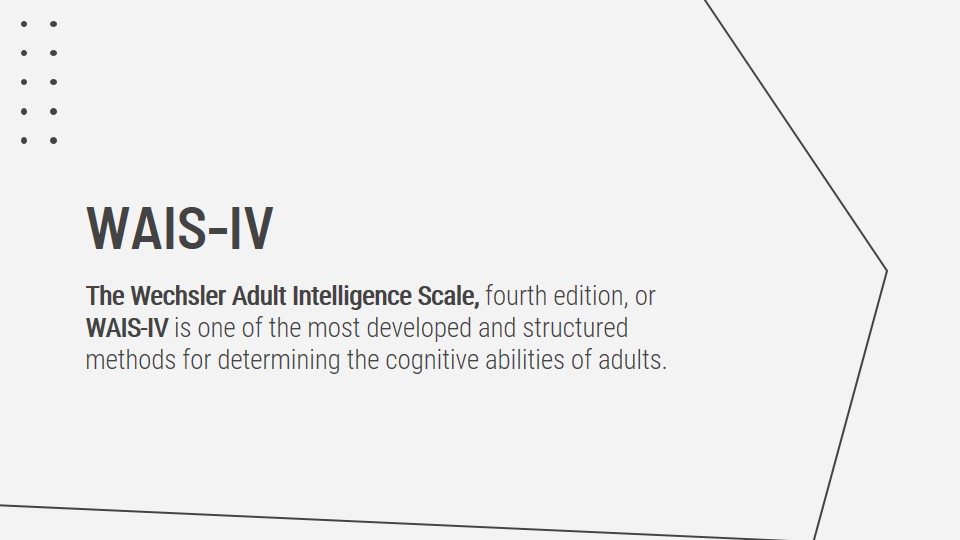
Using the Test
- Qualifications of the User:
- Any adult without special and additional knowledge can access WAIS-IV. The test is specially designed so that it is very user-friendly, easy, and convenient to work with.
- Professional Uses:
- It can be used by psychologists of various specializations, such as geropsychologists & neuropsychologists, as well as for special group studies.
Qualifications: User requirements are not high at all. The test is specially designed so that it is very user-friendly and convenient to work with. Compared with the previous version of the test, administration time was reduced by 15 percent, which corresponds to a simplification of the perception of tasks and a more natural process of their implementation. User-friendliness was also enhanced over WAIS-III, making this test more easy to access.
Profeccional Uses: As a professional use, WAIS-IV will be helpful for psychologists of various specializations. In their work, it can be used by geropsychologists & neuropsychologists, as well as people working on studies of a group of people. Such studies may be, for example, various cognitive impairments, borderline intellectual functioning, for the analysis of which WAIS-IV would be an ideal tool.
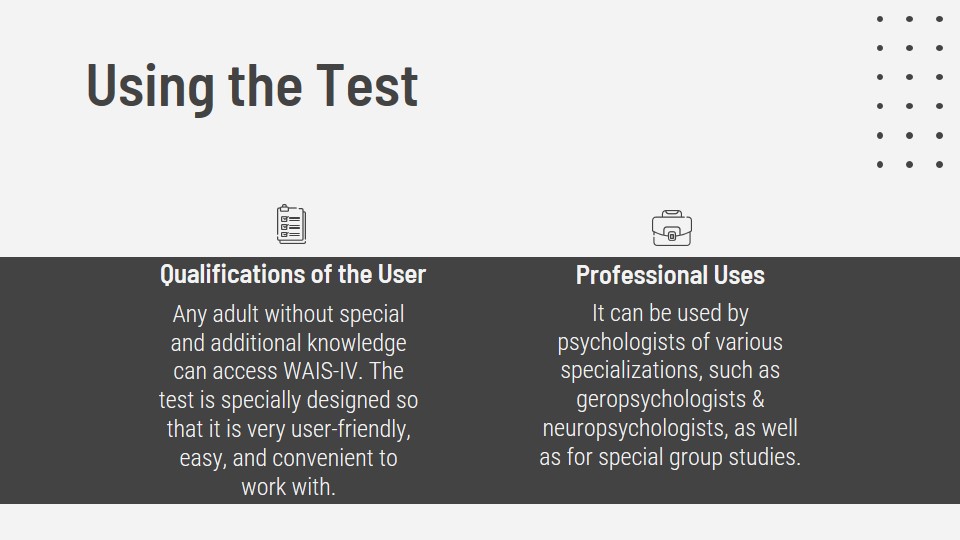
Purpose and Applications of the Test
- 4 Cognitive Parameters – Verbal Comprehension Index (VCI), Perceptual Reasoning Index (PRI), Working Memory Index (WMI), Processing Speed Index (PSI).
- 2 Generalized Parameters – Full-Scale IQ (FSIQ) and General Ability Index (GAI).
- Applications – Intellectual (Autistic Disorder), behavioral (ADHD), and emotional (depression) abnormalities.
- Age Ranges – From 16 to 90 years old inclusively with restrictions of several subtests.
Measurements made using WAIS-IV include measurements of cognitive parameters such as the Verbal Comprehension Index (VCI), Perceptual Reasoning Index (PRI), Working Memory Index (WMI), Processing Speed Index (PSI). At the same time, this test provides two estimates, which are generalized parameters for assessing intellectual abilities: Full-Scale IQ (FSIQ) and General Ability Index (GAI). WAIS-IV was tested on 2,200 US citizens of different ages and 688 Canadians as an advanced standardization confirming the validity of this test.
According to the results of standardization, WAIS-IV is intended for research of people from 16 to 90 years old inclusively. The application of the test can be carried out to identify various intellectual (Autistic Disorder), behavioral (ADHD), and emotional (depression) abnormalities. The only limitations of this test are the use of the Letter-Number Sequencing, Figure Weights, and Cancellation subtests for people over 70 due to their increased fatigue.
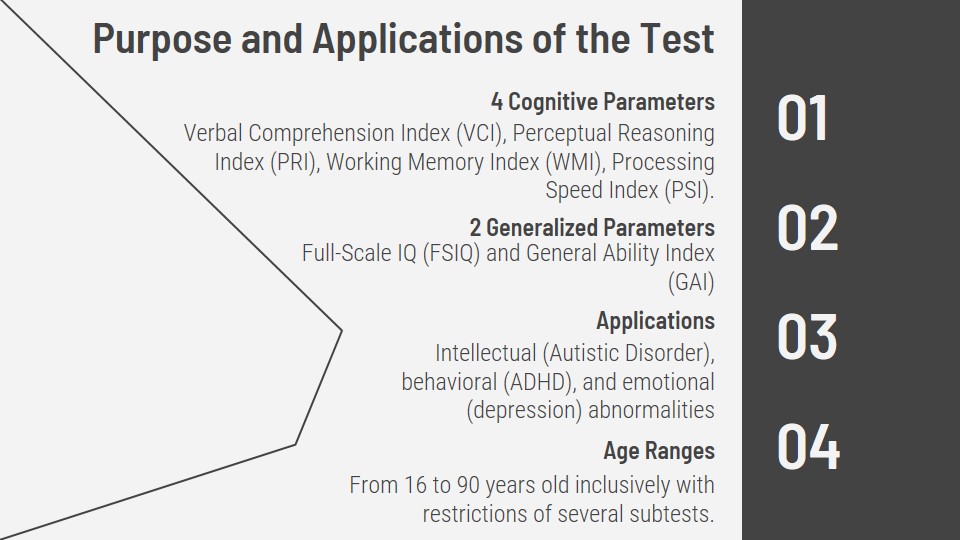
Subtests and Administration
- Improving administration by providing teaching items.
- Reduced administration time.
- Improved tests with graphics and items.
- Improved scoring with reduced visual motor demands.
- High costs of the administration materials.
There are four sections in the structure of the test, each of which includes several subtests. These sections are presented in the picture Verbal Comprehension Scale, Perceptual Reasoning Scale, Working Memory Scale, and Working Memory Scale. In total, there are ten primary subtests and five additional subtests aimed at measuring quantitative and analogical reasoning. The test is focused on visual perception and task performance. For example, testable should decide, which three pieces go together to make the provided puzzle.
To improve and facilitate the process of administration and evaluation, additional teaching items are provided, and tests already existing in the previous edition are improved. Evaluation is carried out on the above parameters VCI, PRI, WMI, PSI by filling out special forms. However, the cost of the administration is high, taking into account the value of all required materials. For example, one basic kit of WAIS-IV costs $1322.
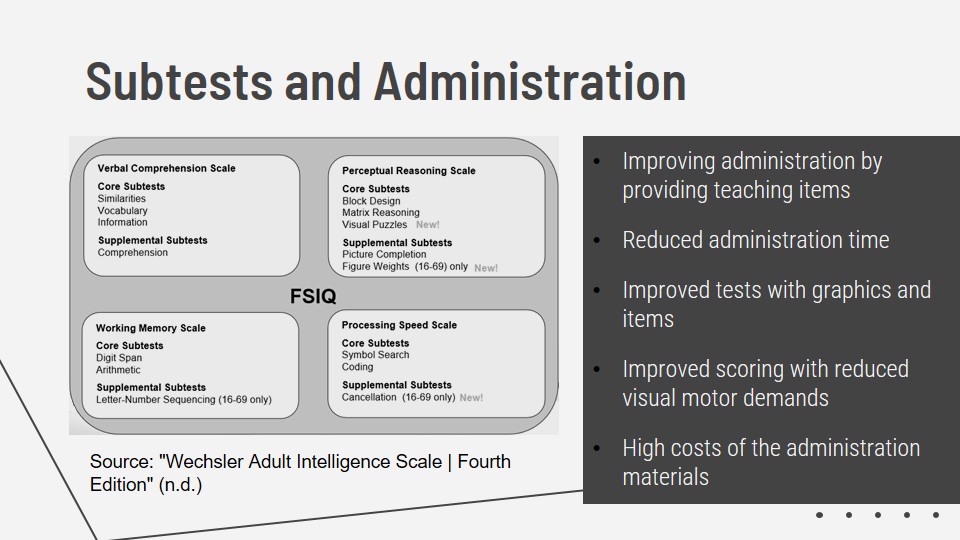
Critique of the Instrument
- Advantages:
- The test is aimed at a broad age range.
- No additional knowledge required.
- Wide variety of subtests.
- Disadvantages:
- Simplicity due to reduced administration time.
- Not all of the test are available to elderly.
After a detailed review, this test has several advantages and definite disadvantages. Firstly, this test is aimed at a broad group of people from 16 to 90 years old, thus covering almost all adults with minimal exceptions. Secondly, no additional knowledge is required to pass the test. There is no need even for well-developed motor skills of hands, which is especially crucial for the elderly. At the same time, due to the wide variety of subtests, WAIS-IV can provide a qualitative assessment of a person’s cognitive abilities, including individual psychological and emotional deviations. However, as the disadvantages of this test as a measure of the theoretical study of intelligence, one can single out its simplification. Although this reduces administration time, there is a suspicion that this can significantly reduce the accuracy of results. However, not all tests are available to people of the older generation, and studies of people after 70 are difficult.
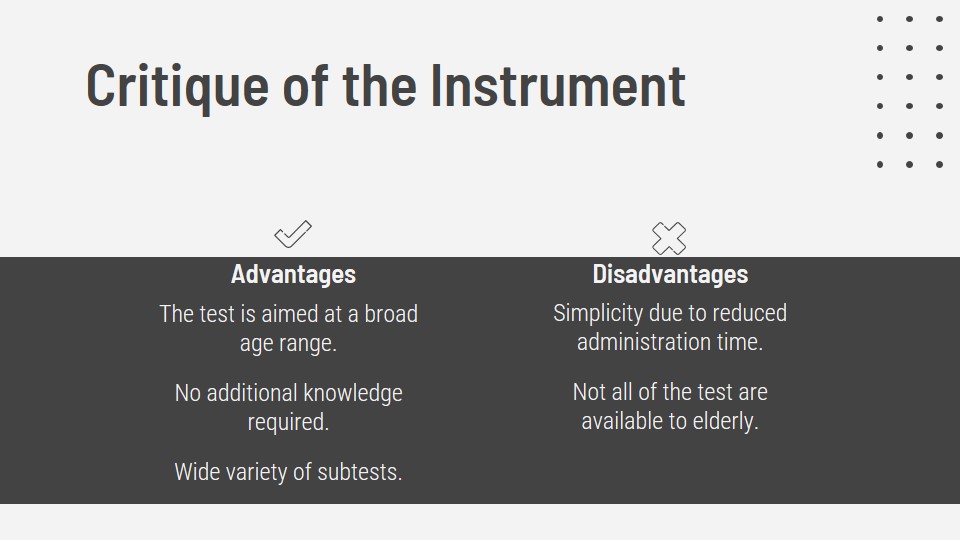
Reviewers’ comments
- WAIS-IV can be used for routine monitoring since it is very time-efficient (Erdodi et al., 2017).
- However, WAIS-IV has low and variable sensitivity and should not be used alone (Erdodi et al., 2017).
As write Erdodi et al. (2017) write, WAIS-IV can be used for routine monitoring, since it does not require the creation of particular conditions. With the help of several simple psychomotor tests, psychologists get access to at least six different parameters, and all this happens without the use of sophisticated and time-consuming tools. Experts single out precisely the speed of passing this test, which makes WAIS-IV so attractive to psychologists. Moreover, even after passing only two tests, the information obtained is more than sufficient to collect extensive data, allowing to evaluate the neurological and cognitive state of the patient. However, Erdodi et al. (2017) note that this test has low and variable sensitivity, a drawback that has passed from the previous generation of this test. Therefore, WAIS-IV should not be used alone to determine the accuracy of a reading.
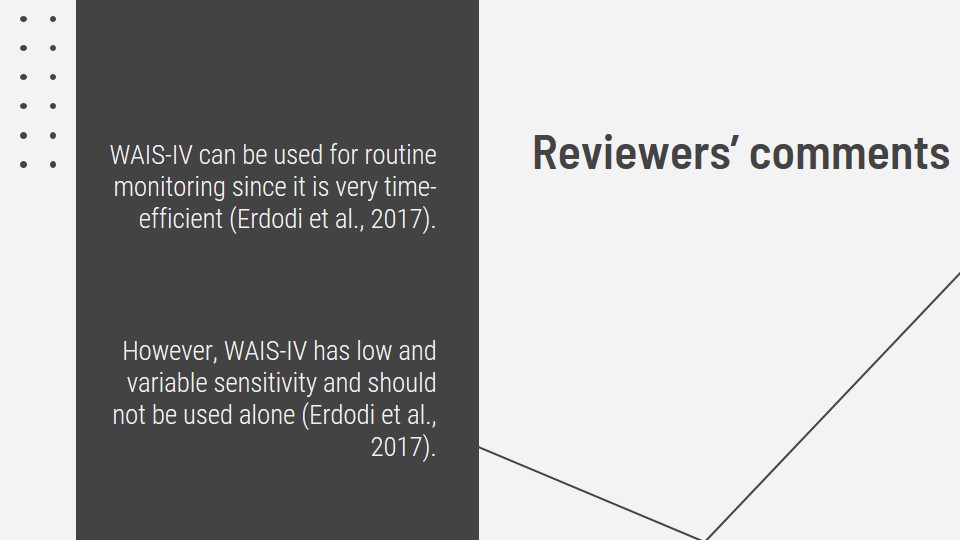
WIAT-III
Wechsler Individual Achievement Test, third edition, or WIAT-III, is one of the most developed systems for assessing the academic abilities of a person.
The next test, unlike the previous one, is more focused on academic achievements and skills than on the general cognitive characteristics of a person. Wechsler Individual Achievement Test, third edition, or WIAT-III, is one of the most developed systems for assessing the academic abilities of a person, such as reading, writing, mathematics, and oratory. David Wechsler is also a creator of this test, which was first published in 1992 and received its third edition in 2009. WIAT-III is an individual assignment and can be used in a variety of settings, from clinical to educational and research. The scope of this test is also not limited to medical institutions since WIAT-III can also be used in schools.
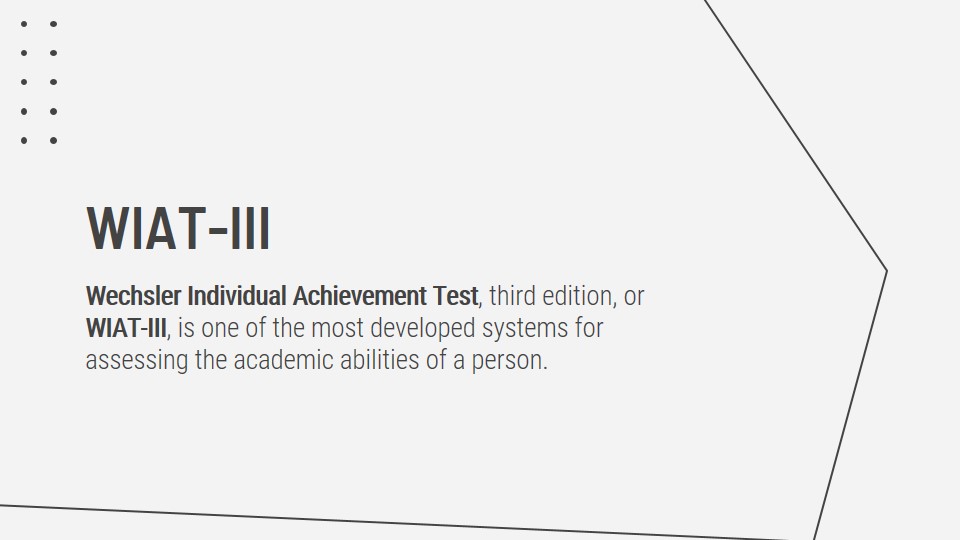
Using the Test
- Qualifications of the User:
- User does not require additional knowledge or preparation, since test aimed at basic skills.
- Professional Uses:
- Teachers, speech therapists, as well as doctors of different profiles can use this test to detect various deviations.
Since this course is aimed at analyzing the basic academic skills of a person, participation in it does not require any specialized knowledge. Therefore, practically everyone who can or only even learns to read and write can take part in it. Moreover, part of this course is specifically aimed at the youngest group of children, those who learn to read early, to identify weaknesses and strengths and possible defects in speech or learning. On the other hand, due to its extensive focus, this test can be used by a whole group of specialists. This list includes speech therapists, teachers in kindergartens and schools, as well as doctors specializing in the treatment of deviations in speech, reading, and writing. One of these abnormalities, for example, is dyslexia, so this test is especially useful for doctors of this profile.
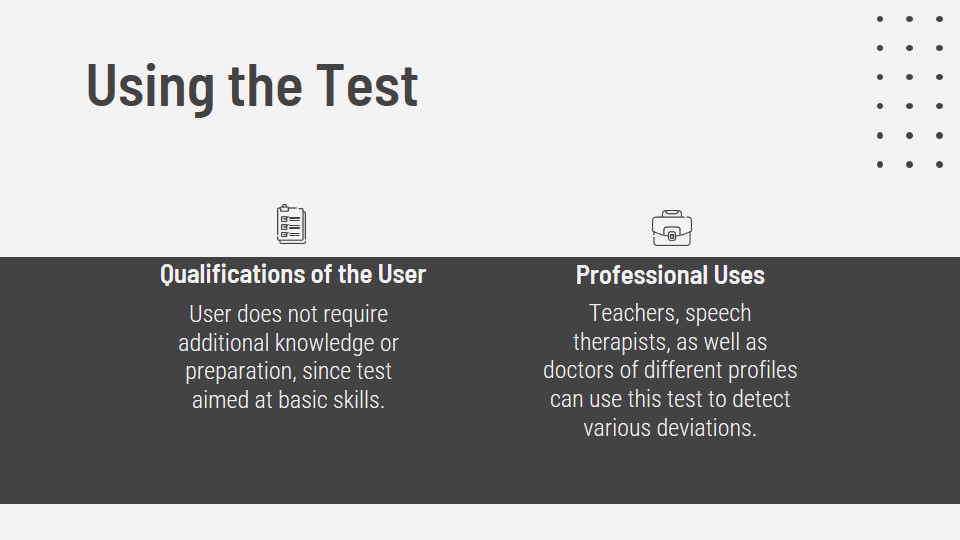
Purpose and Applications of the Test
- 4 Academic Parameters – Reading, Listening, Math, Writing.
- Correlated with Ability Measures – WPPSI-III; WPPSI-IV; WISC-IV; WISC-V; WAIS-IV; WNV; DAS-II.
- Applications – Identifying the general academic strengths and weaknesses and the study of dyslexia.
- Age Ranges – From 4 to 50 years old inclusively without restrictions.
Measurements made using WIAT-III come down to parameters related to reading, listening, math, and writing. In these categories, the speed of reading, the quality of the construction of sentences, the quality of writing an essay and so on are determined. These rather general parameters together give an assessment of the subject’s capabilities. The accuracy of the studies is confirmed by their correlation with other methods of measuring abilities: WPPSI-IV; WAIS-IV; WNV; DAS-II.
In accordance with the results of standardization and testing carried out on 3000 students and adults, WIAT-III is aimed at the age group from 4 to 50 years. In addition to identifying the general inclinations and strengths and weaknesses of the subject, there is a WIAT-III section dedicated to dyslexia separately, which allows the study of patients with this disease at the earliest stages. Information on the prohibition of use for any group of persons is missing.
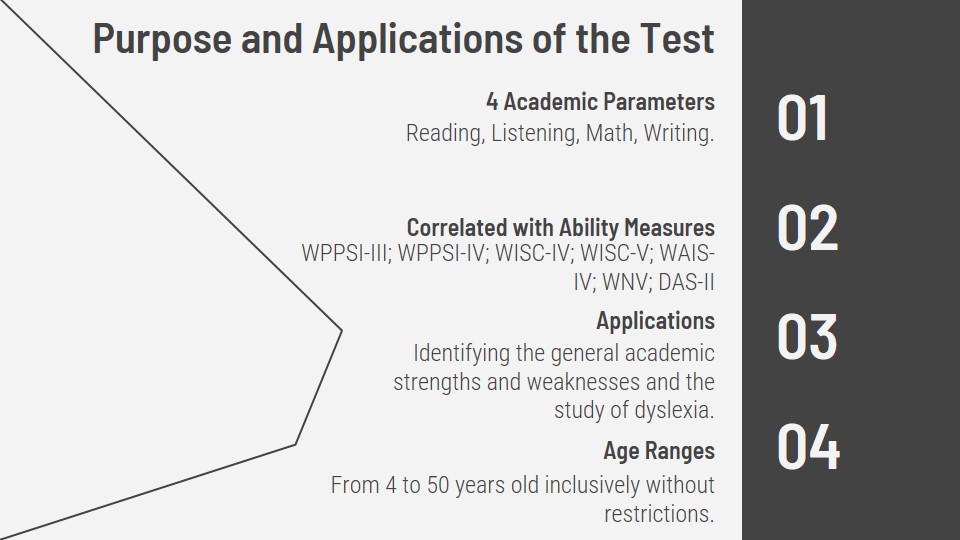
Subtests
- Math: Math Problem Solving, Numerical Operations.
- Writing: Alphabet Writing Fluency, Essay Composition.
- Reading: Early Reading Skills, Word Reading.
- Listening: Listening Comprehension.
WIAT-III includes many different subtests, divided into four main categories discussed on the previous slide: Reading, Listening, Math, Writing. Each group has its own set of assignments revealing certain features of the person being tested. For example, in the Math section, subtests such as Math Problem Solving, Math Fluency, Numerical Operations are presented. The Writing section includes tasks such as the reasonably simple Alphabet Writing Fluency for beginners and a more complicated Essay Composition. The Reading section is more focused on communicating with children and includes Early Reading Skills, Word Reading, and so on. Thus, each of the subtests addresses specific details of the topic under study, whether it is the ability to do mathematical operations or think logically.
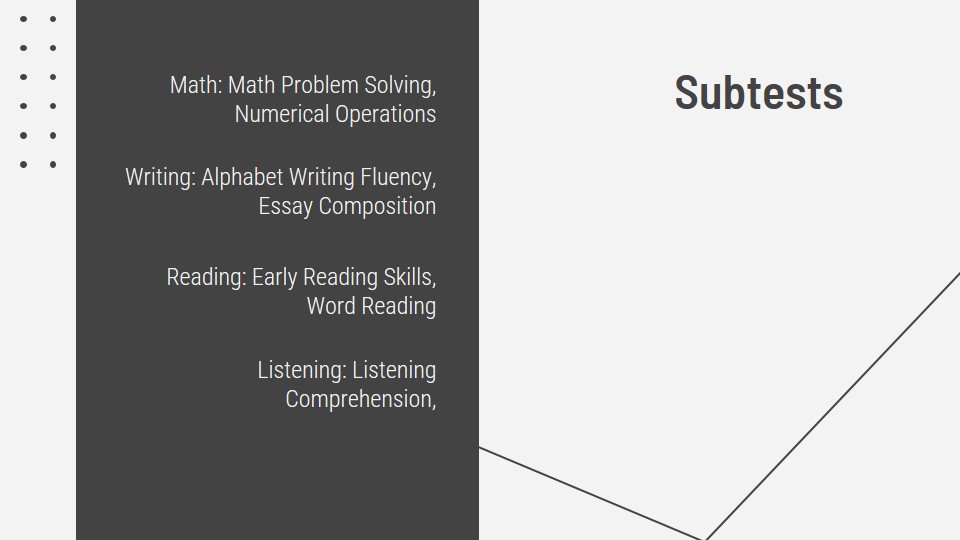
Administration and Costs
- New tests such as Oral Reading, Math Fluency, and Early Reading Skills.
- A wide range of helping tools, reviews and analysis.
- Affordable price of materials.
Like the previous test considered, WIAT-III is not the first version of this complex. Therefore, throughout three versions, the test elements were improved to optimize and speed up the administration. New assignments are also introduced, and old ones reorganized. For example, Oral Reading, Math Fluency, and Early Reading Skills subtests were introduced only in the latest edition, addressing children of an even younger age. At the same time, the usability of WIAT-III is increased, since a wide range of reviews and theoretical analysis is provided for each task from experts and specialists. For the most accurate and convenient use of this complex, together with the basic kit, there is the opportunity to purchase all kinds of administration materials, which greatly endow administration and testing. They include various workbooks, textbooks, letterheads, booklets, and forms for rating. One of their main advantages is an affordable price: about $ 20 for a textbook and about $ 100 for any of the manuals.
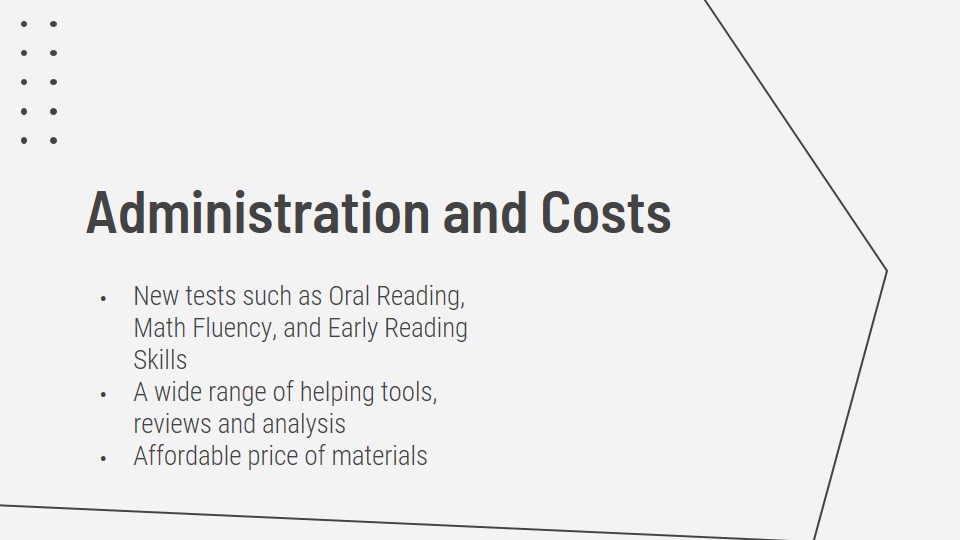
Critique and the Comments
- Flexibility to address weakness and strengths of a person’s academic skills and deviations.
- Suitability for working with young children.
- Relatively low cost of materials and administration.
Caemmerer, Maddocks, Keith, and Reynolds (2018) note, that many tasks require preparation and planning by the administrator. However, WIAT-III have proven itself more successful in some aspects than its analogs.
WIAT-III is a flexible tool that allows you to address the weaknesses and strengths of a person’s academic skills and identify various deviations, including dyslexia. Among the advantages of this test can be noted its suitability for working with young children, as well as the relatively cheap cost of materials for work. On the other hand, there were no immediate, clearly highlighting shortcomings in the analysis of this tool. According to Caemmerer, Maddocks, Keith, and Reynolds (2018), the closest similar test for comparison is WISC-V. Still, experts note, the openness of some WIAT-III subtests, which makes their results more successful. On the other hand, many tasks require careful preparation and planning by the teacher or doctor. Nevertheless, WIAT-III can be called a reliable and useful tool for teachers and doctors working with both children and adults.
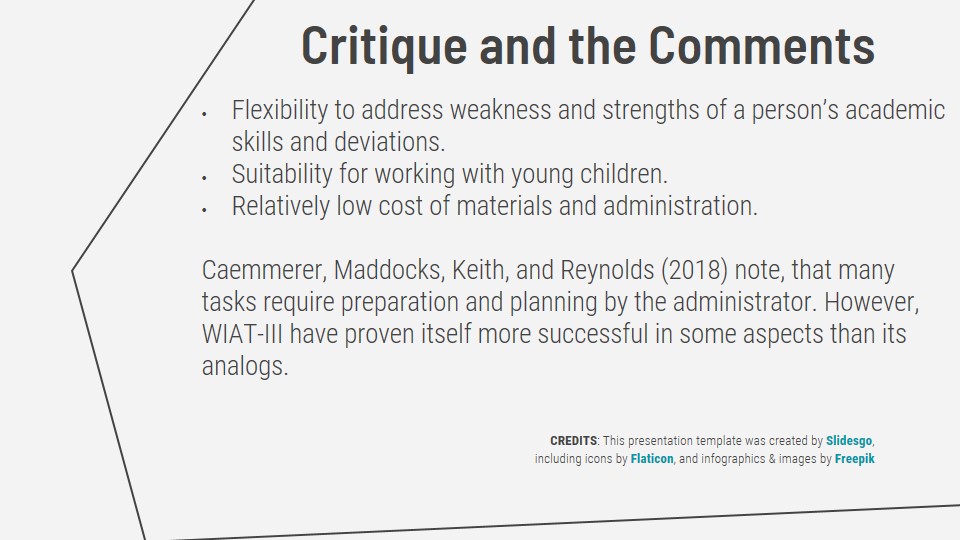
References
Erdodi, L., Abeare, C., Lichtenstein, J., Tyson, B., Kucharski, B., Zuccato, B., & Roth, R. (2017). Wechsler Adult Intelligence Scale-Fourth Edition (WAIS-IV) processing speed scores as measures of noncredible responding: The third generation of embedded performance validity indicators. Psychological Assessment, 29(2), 148–157.
Caemmerer, J., Maddocks, D., Keith, T., & Reynolds, M. (2018). Effects of cognitive abilities on child and youth academic achievement: Evidence from the WISC-V and WIAT-III. Intelligence, 68, 6–20.
Wechsler Adult Intelligence Scale | Fourth edition. (n.d.). Web.
Wechsler Individual Achievement Test | Third edition. (n.d.). Web.